New Questions About Transplantation in Multiple Myeloma
Multiple myeloma is now the most common indication for autologous stem cell transplantation (ASCT) in North America, with over 5,000 transplants performed yearly (Center for International Blood and Marrow Transplant Research [CIBMTR] data). While the role of ASCT as initial therapy in multiple myeloma has been established by randomized studies, newer therapies are challenging the traditional paradigm. The availability of novel induction agents and newer risk stratification tools, and the increasing recognition of durability of remissions are changing the treatment paradigm. However, even with arduous therapy designed to produce more complete remissions—for example, tandem autologous transplants—we have seen no plateau in survival curves. A tandem autologous procedure followed by maintenance therapy may be performed in an attempt to sustain remission. Sequential autologous transplants followed by nonmyeloablative allotransplants are pursued with the hope of "curing" multiple myeloma. We examine how the key challenges of increasing the response rates and maintaining responses are being addressed using more effective induction and/or consolidation treatments and the need for maintenance therapies after ASCT. We argue that given the biologic heterogeneity of multiple myeloma, risk-adapted transplant approaches are warranted. While the role of curative-intent, dose-intense toxic therapy is still controversial, conventional myeloablative allogeneic transplants need to be reexamined as an option in high-risk aggressive myeloma, given improvements in supportive care and transplant-related mortality.
Multiple myeloma is now the most common indication for autologous stem cell transplantation (ASCT) in North America, with over 5,000 transplants performed yearly (Center for International Blood and Marrow Transplant Research [CIBMTR] data). While the role of ASCT as initial therapy in multiple myeloma has been established by randomized studies, newer therapies are challenging the traditional paradigm. The availability of novel induction agents and newer risk stratification tools, and the increasing recognition of durability of remissions are changing the treatment paradigm. However, even with arduous therapy designed to produce more complete remissions-for example, tandem autologous transplants-we have seen no plateau in survival curves. A tandem autologous procedure followed by maintenance therapy may be performed in an attempt to sustain remission. Sequential autologous transplants followed by nonmyeloablative allotransplants are pursued with the hope of "curing" multiple myeloma. We examine how the key challenges of increasing the response rates and maintaining responses are being addressed using more effective induction and/or consolidation treatments and the need for maintenance therapies after ASCT. We argue that given the biologic heterogeneity of multiple myeloma, risk-adapted transplant approaches are warranted. While the role of curative-intent, dose-intense toxic therapy is still controversial, conventional myeloablative allogeneic transplants need to be reexamined as an option in high-risk aggressive myeloma, given improvements in supportive care and transplant-related mortality.
Randomized studies[1,2] suggesting that autologous hematopoietic stem cell transplantation (ASCT) is superior to conventional chemotherapy prompted the adoption of this treatment into standard upfront management of multiple myeloma in eligible patients. Unfortunately, most patients eventually relapse and succumb to the disease despite transplantation. Over the course of the past decade, multiple strategies have been tried to improve the outcome of transplantation for multiple myeloma. These include intensification of therapy using tandem ASCT, immunotherapy approaches involving allogeneic transplantation and reduced-intensity conditioning, posttransplant maintenance therapies, adoptive immune approaches using donor lymphocytes, and the incorporation of novel antimyeloma therapy in induction and maintenance. Within the past 5 years, however, novel antimyeloma treatments have expanded nontransplant options and improved conventional therapy. At the same time, transplants have become increasingly safer and established as standard of care in multiple myeloma.
Single Autologous Transplantation
Prospective randomized clinical trials conducted by the Intergroupe Francophone du Myelome (IFM) group[1] and the Medical Research Council (MRC)[2] have clearly proven that upfront high-dose therapy with ASCT is superior to conventional chemotherapy by improving complete remission (CR) rates and both event-free survival and overall survival in multiple myeloma. Multiple systematic reviews and nonrandomized comparisons have also demonstrated that high-dose therapy is superior to conventional chemotherapy. There are, however, two studies that did not show a benefit.[3,4] In analyzing the ASCT vs chemotherapy studies it must be noted that patient eligibility requirements, the conventional chemotherapy regimen used, the conditioning chemotherapy for transplant, and response criteria have varied among the studies. These data are summarized in Table 1.
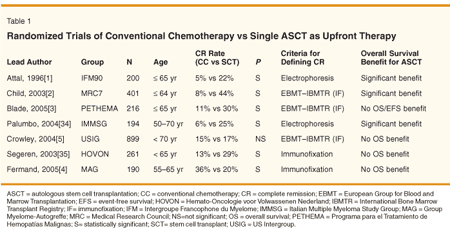
It is interesting to focus on the differences between these investigations. The US Intergroup study[5] is the only randomized study that has failed to show a significant increase in CR rates for ASCT vs conventional chemotherapy. In this study, the transplant conditioning regimen used was melphalan (Alkeran), 140 mg/m2, with total-body irradiation (TBI), which would now be considered suboptimal. Conventional chemotherapy following VAD (vincristine, doxorubicin [Adriamycin], dexamethasone) induction for all patients was VBMCP (vincristine, carmustine [BCNU], melphalan, cyclophosphamide, prednisone) for 1 year. At the time of relapse, patients in the conventional arm were offered ASCT, thus contributing to the lack of a difference in the overall survival. This is also consistent with the French Group Myelome-Autogreffe (MAG) study, which showed no survival differences between early and delayed transplantation.
In contrast, the Programa para el Tratamiento de Hemopatas Malignas (PETHEMA) group[3] randomized patients responding to induction chemotherapy for ASCT vs continuing conventional chemotherapy. Although CR rates were higher with transplantation, no significant differences in the event-free or overall survival between the two arms were observed. These data are consistent with the idea that an increase in CR may not necessarily translate into a survival advantage because patients who are initial responders constitute a good biologic risk group and may not derive significant additional benefit from high-dose therapy.
Similarly, the benefit of ASCT in older patients with multiple myeloma has not been formally established in randomized trials. This is particularly important as the median age at diagnosis of newly diagnosed multiple myeloma is 66 years,[6] whereas the median patient age in the IFM and MRC series is 55 and 57 years, respectively. Pair-mate comparisons have in the past suggested a superiority of ASCT over conventional chemotherapy. However, a randomized study from the MAG group[4] in patients aged 55 to 65 years with 10-year follow-up suggests that despite higher response rates and event-free survival rates, ASCT offers no overall survival benefit over chemotherapy. This study, however, did reveal improved quality-of-life score for patients undergoing ASCT, as measured by time without symptoms, treatment, and treatment toxicity (TwiSTT). Interestingly, 22% of patients in the chemotherapy group underwent ASCT at relapse, no doubt contributing to the similarity of overall survival and emphasizing the feasibility of ASCT in this population.
Complete Remissions and Clinical Benefit
Autologous stem cell transplant is the most powerful modality for achieving CR in multiple myeloma. Complete remission rates with single ASCT have been reported in the 25% to 35% range, whereas tandem autologous transplantation has an expected CR rate ranging from 35% to 50%. Before the advent of novel agents and novel combinations, none of the nontransplant combination regimens could achieve similar CR rates.
That said, the concept of complete response being a paramount determinant in survival in multiple myeloma does not hold up on close analysis. As noted above, the PETHEMA study suggested that in patients responding to initial chemotherapy, higher CR rates with transplantation did not result in a survival benefit. Similarly, the Mayo Clinic experience[7] with single ASCT (where patients who underwent ASCT had a similar progression-free and overall survival whether they achieved CR or not following ASCT) and the Arkansas data[8] showing that a CR at the 1-year landmark after tandem ASCT was not significantly related to overall survival (hazard ratio = 0.83; P = .39) suggest that the attainment of a strict CR does not necessarily predict overall survival. The natural history of multiple myeloma and the lack of concordance between response and survival caution us against using complete response rates as a surrogate for survival benefit.
Finally, the definitions of CR in various multiple myeloma studies have tended to vary widely, confounding cross-comparison. The prognostic significance of the exact method used to define CR is controversial. The IFM studies have expanded the definition of the best response following transplantation to include patients who attain more than a 90% reduction in paraprotein levels. Other groups have also defined "near CR" using the European Bone Marrow Transplant (EBMT)-International Bone Marrow Transplant Registry (IBMTR) criteria,[9] with the exception of immunofixation positivity. Variable and nonstandard criteria for reporting responses following transplant thus continue to confound comparisons of studies
When to Transplant?
Current guidelines recommend upfront ASCT in newly diagnosed patients with multiple myeloma, providing they are acceptable candidates. Randomized data from the MAG group[10] and the US Intergroup S9321, however, suggest that a delayed transplant at relapse from initial response to treatment would be equally efficacious. The quality-of-life analysis in the MAG study favored the early-transplant arm.
In patients who are initial responders to treatment (as noted in the PETHEMA[3] study), ASCT may not add survival benefit over continuing conventional therapy. In initial nonresponders with minimally responsive or primarily resistant disease, ASCT remains the most effective means of achieving a response. Alexanian et al[11] observed that patients with primary resistant disease who received intensification within 1 year achieved a high frequency of response (69%), a 16% CR rate, and a survival benefit. ASCT beyond 1 year was less effective, affirming the greater value of early intensive therapy for these patients. In the Royal Marsden experience,[12] 40% of nonresponders to initial CVAMP therapy (cyclophosphamide, vincristine, doxorubicin [Adriamycin], methylprednisolone) achieved CR with melphalan at 200 mg/m2. In the Mayo Clinic experience,[13] 20% patients in the primary refractory group achieved CRs following high-dose therapy compared to 35% in the chemosensitive group, yet the groups had a similar progression-free survival.
Therefore, the absence of response to initial induction does not preclude a good response to ASCT. The randomized data showing a survival advantage, the demonstrated quality-of-life benefits following early transplant, as well as the benefits even in patients with resistant or nonresponsive disease have established upfront ASCT as standard of care in most national guidelines.
Novel Pretransplant Approaches
Novel antimyeloma combinations are revolutionizing induction treatment and raising new questions in transplantation for multiple myeloma. The most recently approved novel agents-thalidomide (Thalomid), bortezomib (Velcade), and lenalidomide (Revlimid)-in combinations with traditional agents have transformed the therapeutic options available to patients with relapsed multiple myeloma and are now being integrated into induction treatment. Initial studies have been extremely promising, with response rates close to 90% and with complete response rates close to 25%. Table 2 summarizes some of the novel combinations for upfront therapy in newly diagnosed multiple myeloma.
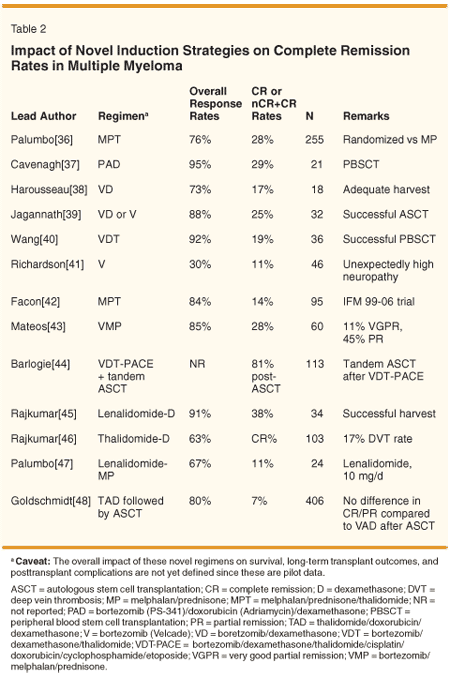
It must be noted that the durability of CRs induced by novel agent combinations is unknown at this time. If the sustainability of these responses are proven with longer follow-up, it is likely that such induction combinations might displace or delay high-dose treatment. Furthermore, no prospective studies have assessed whether a change to a novel nontransplant induction treatment prior to ASCT is warranted in initial nonresponders. This becomes an increasingly relevant question, since plasma cell burden at the time of transplant is a prognostic factor in overall outcome and effective novel combinations are now available for initial nonresponders prior to or as an alternative to ASCT.
Various current strategies being employed to improve overall outcomes for ASCT in multiple myeloma are summarized in Table 3.
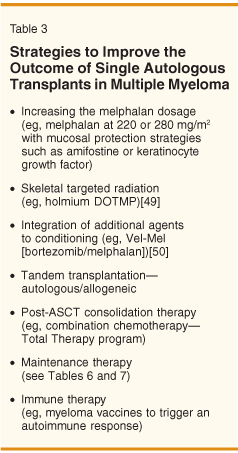
Biologic Risks in Multiple Myeloma
Multiple myeloma has distinct biologic features that predict the natural history and response to therapy. Investigators have characterized some of the biologic risk factors, including elevated beta-2 microglobulin, low serum albumin, high plasma cell labeling index, circulating plasma cells, elevated LDH, and several defined cytogenetic abnormalities. Indeed, the new international staging system[14] for multiple myeloma uses serum albumin and beta-2 microglobulin to stratify patients in three distinct stages, with median survivals of 62, 44, and 29 months, respectively. Even in patients undergoing upfront ASCT within 9 months of diagnosis, the staging system was predictive of overall survival, with median survivals of 111, 68, and 45 months, respectively, for the three stages. This suggests that even without cytogenetic markers, using universally available clinical variables, distinct subpopulations can be identified with widely varying prognostic outcomes.
Biologic heterogeneity may account for a significant amount of variation seen in the different clinical trials. High-risk aggressive multiple myeloma defined biologically may not benefit from the attainment of rapid tumor reduction because the disease rapidly progresses after ASCT. On the other hand, biologically less aggressive disease could well be induced into a chronic indolent state without attaining a true CR. In fact, progression may be the most important variable associated with overall survival. This idea is supported by a combined analysis of four different Southwest Oncology Group (SWOG) phase III protocols, into which more than 1,500 patients were enrolled over a decade.[15] The analysis showed that the time of disease progression, rather than the magnitude of response to frontline therapy, predicted overall survival.
Cytogenetic Prognostic Factors
Distinct abnormalities of chromosome 13 (?13)-either deletion or monosomy-are the most established cytogenetic changes linked to poor clinical outcome. Depending on detection techniques, the proportion of cases bearing ?13 can vary: 15% by metaphase karyotyping to 50%-60% by fluorescence in situ hybridization (FISH). Chromosome 13 abnormalities by metaphase karyotyping are more strongly associated with unfavorable outcomes after conventional chemotherapy and ASCT. The negative impact of ?13 on outcome is not overcome by either autologous or allogeneic transplant strategies. The median survival after a single autologous ASCT in patients with ?13 ranges from 24 to 27 months, compared to greater than 60 months in patients without ?13.
Even with allogeneic transplants, the prognosis remains dismal for ?13 multiple myeloma. Thus, even the graft-vs-myeloma effect resulting from allogeneic transplants is insufficient to prevent progression in patients with ?13. The failure to overcome the adverse impact of ?13 even with tandem transplants -(autologous/autologous or autologous/allogeneic) indicates that novel therapeutic approaches are required in this subgroup.
Other cytogenetic abnormalities involving immunoglobulin heavy chain (IgH) locus (14q32) are associated with variable outcomes. Translocations involving IgH and 4p16 or 16q23 are associated with poor outcomes. In contrast, the t(11;14) translocation, the cyclin D1 (CCD1) locus, is associated with improved or unchanged survival. Finally, hypodiploidy as well as the presence of myelodysplastic syndrome (MDS)-like cytogenetic abnormalities associated with multiple myeloma have also been reported as poor prognostic factors. These data are summarized in Table 4.
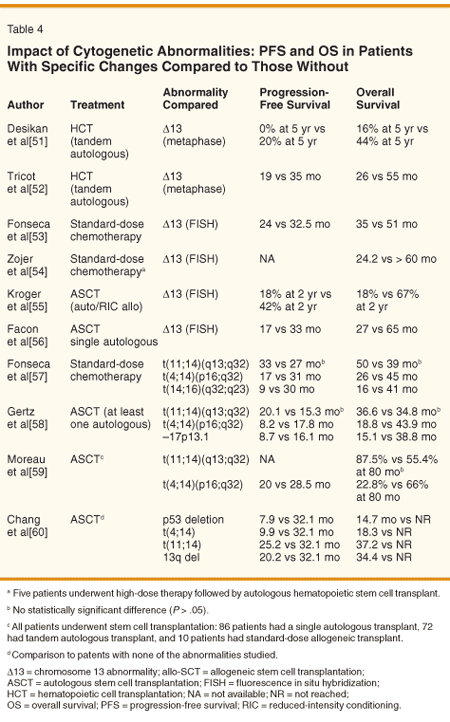
Risk stratification in multiple myeloma has thus defined subsets of patients who have poor outcomes despite intense treatment allocation. It is important to profile biologic risks in multiple myeloma patients at diagnosis. With better techniques (FISH, gene-expression profiling, custom gene chips), our ability to identify high-risk patients is improving. Patients who may not derive optimal benefit from standard-of-care transplant approaches should be treated on clinical trials utilizing risk-adapted strategies to guide the treatment. Data presented by the Arkansas group from their Total Therapy II study showed that the benefit of adding thalidomide throughout the treatment program was limited to patients who lacked metaphase cytogenetic abnormalities.[17] In contrast, the adverse prognosis of high-risk cytogenetics may be overcome using bortezomib-based therapy in patients with chromosome 13 deletions.[16]
Tandem Autologous Transplant
Although the feasibility of double intensification with ASCT had been reported in the late 1980s, the Arkansas group pioneered the tandem planned autologous transplant approach in their Total Therapy I program, with non-cross-resistant induction chemotherapy regimens culminating in tandem autologous transplantation.[18] They observed impressive event-free and overall survival times of 43 months and 68 months, respectively-superior to historical controls. The results of the Total Therapy II trial, which incorporates thalidomide into a tandem transplant approach, have also been reported.[19] Superior 5-year continuous complete remissions (60%) and improved event-free survival (50% at 5 years) were shown for the addition of thalidomide. The current Arkansas approach-Total Therapy III-includes bortezomib in the induction regimen and posttransplant consolidation. When recently updated, with a total of 891 patients enrolled into frontline Total Therapy programs, the 10-year event-free and overall survival rates were 18% and 23%, and 12% of patients had survived for more than 15 years.
The French have published the only randomized trial (IFM 94)[20] comparing single to double ASCT. Previously untreated multiple myeloma patients were randomized to a single ASCT (using melphalan at 140 mg/m2 plus TBI at 8 Gy) or a double ASCT (melphalan at 140 mg/m2 followed by melphalan at 140 mg/m2 plus TBI at 8 Gy). The projected 7-year event-free and overall survival benefits were significantly improved for the double ASCT arm (10% vs 20% for event-free survival and 21% vs 42% for overall survival, respectively). Four other randomized trials have compared single to double intensive therapy (Table 5). The preliminary data show an event-free survival benefit for the tandem approach in four out of the five studies. An overall survival benefit has been shown only for the IFM 94 study. However, a recent reanalysis of the MAG 95 trial[21] demonstrated that the subgroup of patients who received non-CD34+-selected stem cell products had a superior overall survival in the tandem arm (30% vs 40% at 7 years, P = .04), although the event-free survival was still similar.
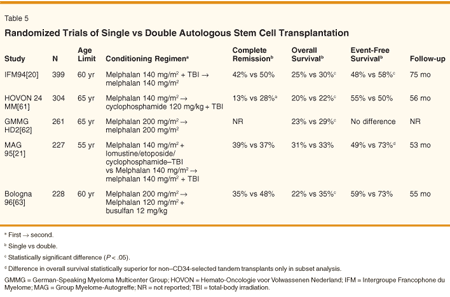
Who Benefits From Tandem Transplantation?
In the IFM 94 trial[20] improved event-free and overall survival was not observed in the tandem ASCT arm until 4 years of follow-up had passed, at which time the survival curves diverged. Furthermore, the investigators did not find a significant increase in CR with the second ASCT on an "intent to treat" basis, although patients who completed the second transplant did have a higher CR rate compared to patients who had only a single transplant (63% vs 49%, respectively). The subset of patients who benefited from the second planned ASCT were those who did not achieve a CR or a very good PR within 3 months after the first ASCT. In this subset, the probability of 7-year survival was 11% with single transplant vs 43% with the tandem approach. The preliminary Bologna 96 data[22] also suggest that tandem ASCT is beneficial only to those patients who did not achieve a CR or near CR following the first transplant.
The difference in projected survival with tandem ASCT does not correlate with improved response rates, but more likely does with longer duration of responses. This explains why differences in survival are not apparent with shorter follow-up in the other randomized studies of tandem transplantation. Of note, the IFM 94 results appear inferior to the Arkansas tandem ASCT data in terms of CR, event-free survival, and overall survival. These differences may be related to differences in patient selection, induction, and, most likely, the transplant conditioning therapy: the IFM 94 utilized melphalan at 140 mg/m2 followed by melphalan at 140 mg/m2 plus TBI at 8 Gy (total melphalan dose = 280 mg/m2), whereas the Arkansas regimen was melphalan at 200 mg/m2 followed by melphalan at 200 mg/m2 (total dose = 400 mg/m2).
Based on the IFM 94 and Bologna 96 subgroup analyses, a patient who fails to achieve a very good PR after the first ASCT should be offered a second transplant. Therefore, stem cell collections in multiple myeloma patients should aim at collecting sufficient stem cells to perform at least two ASCTs, while the timing of the second transplant should be decided after assessing the response to the first. Routine tandem transplants in patients already in CR or near CR after their first ASCT are controversial and should be considered in the context of well-designed clinical trials.
For the highest-risk group patients, discussed above, tandem transplant alone is insufficient and these patients need to be considered for trials incorporating innovative strategies (eg, maintenance with newer agents, vaccine therapy, or conventional allotransplants) to overcome these adverse biologic factors.
Timing of a Second Transplant
The success of salvage second transplants at relapse is the basis for the standard practice of harvesting adequate stem cells for at least two transplants. However, the appropriate timing of a second ASCT in patients who have undergone a prior ASCT has not been determined. The IFM 94 and Bologna 96 results suggest that for patients who do not achieve a very good PR or near CR within 3 months after the first transplant, an immediate second ASCT is beneficial. However, no randomized studies have compared a salvage second transplant at relapse to a planned upfront tandem second transplant.
Maintenance Therapy
Maintenance therapy is a well-recognized strategy to prolong disease-free survival after primary therapy, either chemotherapy or transplant. Ideally, maintenance treatment should produce minimal side effects, be active against myeloma, simple to administer, and, ultimately, improve event-free and overall survival without compromising quality of life.
Interferon
Cunningham et al[23] studied the role of interferon maintenance after autologous ASCT in patients who responded to transplant. Although initial data showed improved progression-free and overall survival in patients randomized to interferon maintenance, with longer follow-up, no differences in progression-free or overall survival were demonstrated. The US Intergroup S9321[5] study randomized responding patients after completion of either ASCT or VBMCP to interferon vs observation. No significant benefit for interferon maintenance was observed in either arm. Finally, a retrospective database analysis from the EBMT registry[24] compared patients who received interferon or observation. Interferon appeared to improve progression-free and overall survival, with patients who achieved less than a CR after ASCT benefiting the most from such maintenance. In summary, there is no basis for the use of interferon maintenance outside of a well-designed clinical trial.
Immunomodulators
Novel antimyeloma agents are also being evaluated as maintenance therapy. Thalidomide has shown promise as maintenance therapy post-ASCT. The Arkansas group Total Therapy II program added consolidation chemotherapy with or without thalidomide post-ASCT. Results of the randomized IFM 9902 trial demonstrated improved 4-year progression-free survival in the thalidomide-plus-pamidronate arm compared to no maintenance or pamidronate alone (50% vs 39% and 37%, respectively, P < .02). The final analysis of this trial showed an overall survival advantage for the thalidomide maintenance arm.[25] The subgroup of patients who showed an event-free survival advantage were those who had a high beta-2 microglobulin at diagnosis but not chromosome 13 deletions.
Unfortunately, thalidomide is associated with significant toxicities that are dependent upon dose and treatment duration. For example, in the National Cancer Institute of Canada (NCIC)-MY9 trial,[26] which randomized patients to 200 or 400 mg of thalidomide combined with alternate-day 50-mg prednisone, the 400-mg arm was prematurely stopped due to excessive toxicity. In the 200-mg thalidomide arm, 31% of patients required dose reductions, yet 76% were able to continue maintenance beyond 18 months.
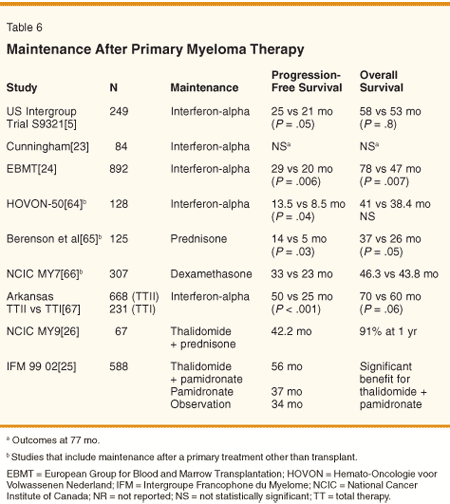
Tables 6 and 7 summarize the role of maintenance therapy after primary treatment and our recommendations for posttransplant maintenance.
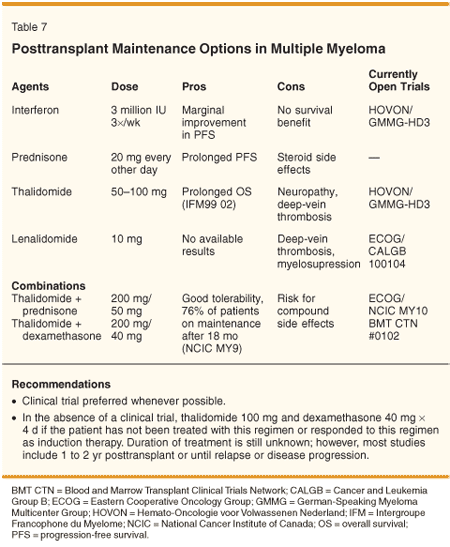
Allogeneic Transplantation
Allogeneic stem cell transplants have the potential for eradicating multiple myeloma completely since the graft source is tumor-free and there exists a proven graft-vs-myeloma effect in multiple myeloma. Patients surviving allogeneic transplants frequently have a durable molecular CR and a significantly reduced risk of relapse compared to autologous transplants.
Reduced-Intensity Conditioning Allogeneic Transplants
Nonmyeloablative stem cell transplantation (NST) or reduced-intensity conditioning (RICT) represents an attempt to harness the well-documented graft-vs-myeloma effect while reducing transplant-related mortality. The feasibility of this approach has been demonstrated in both the upfront and salvage settings. The Seattle group[27] reported on their results in three groups of patients: relapsed patients who had failed prior ASCT (n = 14), relapsed patients who had not received prior ASCT (n = 19), and a third group who were candidates for a sequential ASCT followed by NST (n = 84). The predicted 4-year overall survival rates were 40%, 35%, and 70% in the corresponding groups, while transplant-related mortality was 2% at day 100 and 17% overall.
In relapsed multiple myeloma patients, a number of groups have shown high response rates and relatively low 100-day transplant-related mortality. However, the 1-year transplant-related mortality has ranged from 15% to 40%, and no plateau in event-free survival has been observed in any of the studies. Therefore, in the salvage setting, this approach should not be considered outside of a well-designed clinical trial.
Planned Sequential Autologous Followed by NST Allogeneic Transplantation
This strategy combines the benefits of an initial autologous transplantation for steep tumor reduction followed by a planned tandem NST allotransplant aimed at harnessing the graft-vs-myeloma effect to eradicate minimal residual disease, with the ultimate goal of long-term disease control. Pilot data (Table 8) have yielded excellent short-term (24-month) event-free and overall survival rates, with 1 year transplant-related mortality ranging from about 11% in patients with matched-related donors to 26% in patients with unrelated donors. In the sequential ASCT/NST data from Seattle, sensitive disease prior to transplant predicted lower transplant-related mortality (7% vs 27%). Posttransplant, the presence of chronic graft-vs-host disease predicted better event-free and overall survival, but acute graft-vs-host disease had a significant adverse impact on survival.
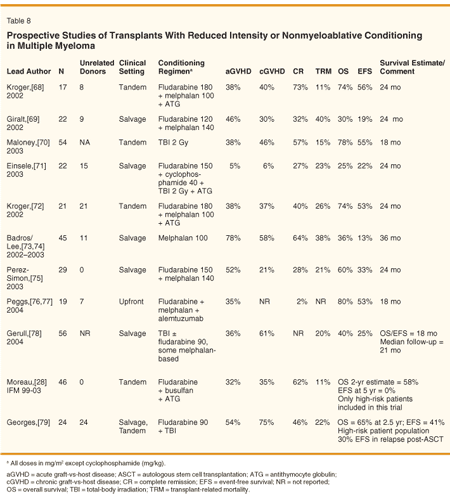
The only randomized studies reported to date comparing tandem autologous transplants to an ASCT followed by NST approach are the IFM 9903/9904 trials, which enrolled patients with high-risk myeloma (beta-2 microglobulin > 3 mg/dL and chromosome 13 deletion).[28] A total of 65 patients with matched-sibling donors were assigned to the autologous/NST arm (IFM 9903 trial), and 219 patients were assigned to the tandem autologous transplant arm (9904 trial). With a median follow-up of 24 months, on an intent-to-treat basis, the overall survival in the ASCT/ASCT vs ASCT/NST was similar (P = .07). Thus, in patients with high-risk de novo multiple myeloma, the combination of ASCT/NST was not superior to tandem autologous transplantation.
The upfront strategy of a single ASCT followed by an allogeneic NST-although feasible, with transplant-related mortalities in the 10% to 20% range-is not a readily available option for the majority of patients with newly diagnosed multiple myeloma. Updates of the German and Seattle tandem autologous-NST studies report a continuing risk of relapse with no plateau in relapse curves and a 40% progression-free survival rate at 3 years. Similar results have been observed with matched-related or unrelated donors.
The most recent data concerning tandem/sequential transplants was presented at the annual meeting of the American Society of Hematology (ASH) in December 2005. Bruno et al[29] reported the Italian experience, comparing 56 patients receiving an ASCT/NST to 73 patients receiving a tandem ASCT. At a median follow-up of 3 years, CR (46% vs 16%), event-free survival (61% vs 38%), and overall survival (84% vs 62%) rates were significantly superior in the ASCT/NST arm. Transplant-related mortality in this arm was a modest 11%. The PETHEMA group[30] reported their results in assigning patients who had not achieved a CR or near CR after an ASCT to a matched-sibling NST or a second ASCT: 59 patients who received a tandem ASCT were compared to 23 who underwent ASCT/NST. Despite higher CR rates in the ASCT/NST group, there was no improvement in overall survival. Transplant-related mortality was 17% in the NST group.
In summary, the graft-vs-myeloma effect alone may not be sufficient to maintain disease-free responses after NST. The best results of ASCT/NST have been observed in patients who have chemosensitive disease without adverse markers such as ?13 defined by FISH or beta-2 microglobulin > 3 mg/dL and low tumor burden (allotransplant within 12 months of ASCT). For the present, while randomized trials of ASCT/NST approaches are underway with genetic assignment to the allogeneic arm in both Europe and the United States (BMT Clinical Trials Network 0102), the tandem ASCT followed by NST approach remains investigational.
Conventional Allotransplants: Time to Reconsider?
Conventional allogeneic transplantation with myeloablative conditioning is associated with a significantly worse event-free and overall survival than autologous transplantation. This inferior outcome is related to a significantly higher transplant-related mortality-reported as high as 50% in some studies[31]-in patients receiving conventional allogeneic transplantation.
Reduced-intensity conditioning strategies for myeloma arose from attempts to reduce the prohibitive transplant-related mortality associated with myeloablative allotransplants. However, the reduction in early transplant-related mortality with this strategy has not translated into a plateau in survival in any of the reported NST/RICT studies. Patients continue to relapse and the relapse risk may be as high as 60% in the first 3 years.
In contrast, conventional myeloablative allotransplant patients seem to have a plateau in progression-free survival at 25% at 6 years, as observed by the US Intergroup S9321 study, or at least a longer progression-free interval, as described by an EBMT analysis. Arora et al[32] reported an encouraging 4-year survival rate of 64% in their ablative allotransplant patients, compared to 50% (P = .04) in the autologous transplant setting. Thus, for patients escaping initial transplant-related mortality after transplant, overall and event-free survival were significantly superior in the allogeneic setting.
There is reason to anticipate that general advances in HLA typing, antifungal therapy, and supportive care could make myeloablative regimens safer in terms of transplant-related mortality. Indeed, EBMT data[33] indicate that transplant-related mortality has decreased significantly over the past 10 years to approximately 25% with improved supportive care and patient selection. It may be premature, therefore, to abandon myeloablative allotransplants before mature follow-up data in the NST/RICT setting become available.
Patient Selection for Allogeneic Transplants
The decision to proceed to an allograft in multiple myeloma should be made in conjunction with the choices of a well-informed patient. Initial risk stratification, response to induction therapy, chemosensitivity, presence or absence of defined cytogenetic abnormalities, availability of a donor, performance status, as well as the patient's desires need to be taken into account. Even so, considering the limited follow-up data and the minority of patients who appear to have a probability of molecular CR or long-term "cure," we do not feel that the possibility of cure should be used to justify the use of any allograft modality outside of a clinical trial.
Conclusions
Randomized clinical trials involving traditional chemotherapy comparisons have firmly established the role of upfront autologous ASCT in newly diagnosed multiple myeloma. While novel agents alone or in combination might result in CR rates comparable to those seen with single ASCT, we currently have insufficient data to abandon ASCT. With additional time, the newer agents may either supplant transplantation or change our current algorithm by delaying transplants until disease relapse (since there is evidence that delayed transplantation is equally efficacious for survival).
Tandem ASCTs have consistently produced better event-free survival rates compared to single autologous ASCT, but, to date, only the IFM 94 trial has shown a clear overall survival advantage. Given the improvement in salvage therapies, superior event-free survival coupled with maintenance of quality-of-life scores could be considered a valid and meaningful primary outcome measure in maintenance trials, ahead of overall survival. We recommend the collection of sufficient autologous stem cells for at least two transplants and proceeding to tandem ASCT if the patient does not enter at least a very good partial remission (defined as a decrease in paraprotein by > 90% from diagnosis) after the first ASCT. We consider this the standard of care at this time.
For patients who achieve a very good partial remission, near CR, or CR, a second transplant should be reserved for disease progression. Patients should be encouraged to participate in maintenance trials of the newer antimyeloma agents that have shown promise in nontransplant settings. Patients with adverse biologic prognostic factors do not benefit from the current ASCT treatment approaches . These patients should be treated aggressively on innovative protocols whenever possible.
Allogeneic transplant strategies for multiple myeloma need to be continually reevaluated in the changing context of novel induction strategies, better prophylaxis against graft-vs-host disease, improving maintenance therapy, minimal residual disease monitoring, and improving supportive care. Nonmyeloablative allogeneic transplants should only be considered for patients early in their disease course (not as salvage) with chemosensitive, non-high-risk disease who are enrolled on well-designed clinical trials. Conventional allogeneic transplantation should be considered in younger patients early in their disease course with good performance status and acceptable physiologic organ function.
Finally, even if none of the current strategies approach a cure, benefits in terms of time to progression achieved at low toxicity will ensure that prolonged disease-free remissions can be achieved without compromising quality of life.
Disclosures:
Dr. Hari is a member of the speakers bureau for Celgene.
References:
1. Attal M, Harousseau JL, Stoppa AM, et al: A prospective, randomized trial of autologous bone marrow transplantation and chemotherapy in multiple myeloma. Intergroupe Francais du Myelome. N Engl J Med 335:91-97, 1996.
2. Child JA, Morgan GJ, Davies FE, et al: High-dose chemotherapy with hematopoietic stem-cell rescue for multiple myeloma. N Engl J Med 348:1875-1883, 2003.
3. Blade J, Rosinol L, Sureda A, et al: High-dose therapy intensification compared with continued standard chemotherapy in multiple myeloma patients responding to the initial chemotherapy: Long-term results from a prospective randomized trial from the Spanish cooperative group PETHEMA. Blood 106:3755-3759, 2005.
4. Fermand JP, Katsahian S, Divine M, et al: High-dose therapy and autologous blood stem-cell transplantation compared with conventional treatment in myeloma patients aged 55 to 65 years: long-term results of a randomized control trial from the Group Myelome-Autogreffe. J Clin Oncol 23:9227-9233, 2005.
5. Crowley J, Fonseca R, Greipp P, et al: Comparable survival in newly diagnosed multiple myeloma (MM) after VAD induction with high dose therapy using melphalan 140mg/m2 + TBI 12 Gy (MEL+TBI) versus standard therapy with VBMCP and no benefit from interferon (IFN) maintenance: final clinical results of Intergroup trial S9321 in the context of IFM 90 and MRC VII trials (abstract 539). Blood 104:539a, 2004.
6. Kyle RA, Gertz MA, Witzig TE, et al: Review of 1027 patients with newly diagnosed multiple myeloma. Mayo Clin Proc 78:21-33, 2003.
7. Rajkumar SV, Fonseca R, Dispenzieri A, et al: Effect of complete response on outcome following autologous stem cell transplantation for myeloma. Haematologica 26:979-983, 2000.
8. Tricot G, Reiner M, Sawyer J, et al: A complete remission (CR) is not a prerequisite for prolonged survival after autotransplants for multiple myeloma (abstract 926). Blood 104:11, 2004.
9. Blade J, Samson D, Reece D, et al: Criteria for evaluating disease response and progression in patients with multiple myeloma treated by high-dose therapy and haemopoietic stem cell transplantation. Myeloma Subcommittee of the EBMT. European Group for Blood and Marrow Transplant. Br J Haematol 102:1115-1123, 1998.
10. Fermand JP, Ravaud P, Chevret S, et al: High-dose therapy and autologous peripheral blood stem cell transplantation in multiple myeloma: Up-front or rescue treatment? Results of a multicenter sequential randomized clinical trial. Blood 92:3131-3136, 1998.
11. Alexanian R, Weber D, Delasalle K, et al: Clinical outcomes with intensive therapy for patients with primary resistant multiple myeloma. Haematologica 34:229-234, 2004.
12. Singhal S, Powles R, Sirohi B, et al: Response to induction chemotherapy is not essential to obtain survival benefit from high-dose melphalan and autotransplantation in myeloma. Haematologica 30:673-679, 2002.
13. Kumar S, Lacy MQ, Dispenzieri A, et al: High-dose therapy and autologous stem cell transplantation for multiple myeloma poorly responsive to initial therapy. Haematologica 34:161-167, 2004.
14. Greipp PR, San Miguel J, Durie BG, et al: International staging system for multiple myeloma. J Clin Oncol 23:3412-3420, 2005.
15. Durie BG, Jacobson J, Barlogie B, et al: Magnitude of response with myeloma frontline therapy does not predict outcome: Importance of time to progression in southwest oncology group chemotherapy trials. J Clin Oncol 22:1857-1863, 2004.
16. Jagannath S, Richardson PG, Sonneveld P, et al: Bortezomib appears to overcome poor prognosis conferred by chromosome 13 deletion in phase 2 and 3 trials (abstract 6501). J Clin Oncol 23(16S):560s, 2005.
17. Barlogie B, Hanamura I, Burington B, et al: Shorter post-relapse survival (PRS) of myeloma (MM) patients randomized to the thalidomide (T) arm of Total Therapy 2 (TT2) related to chromosome 1q21 amplification (AMP1Q21, FISH) at relapse (abstract 1155). Blood vol 106, 2005.
18. Barlogie B, Jagannath S, Desikan KR, et al: Total therapy with tandem transplants for newly diagnosed multiple myeloma. Blood 93:55-65, 1999.
19. Tricot G, Rasmussen E, Anaissie E, et al: Total therapy 2 (TT2) for multiple myeloma (MM): Thalidomide (T) effects superior complete response (CR) and event-free survival (EFS); similar overall survival (OS) linked to shorter post-relapse survival (abstract 423). Blood 106:127a, 2005.
20. Attal M, Harousseau JL, Facon T, et al: Single versus double autologous stem-cell transplantation for multiple myeloma. N Engl J Med 349:2495-2502, 2003.
21. Fermand JP: High dose therapy supported with autologous blood stem cell transplantation multiple myeloma: Long term follow up of the prospective studies of the MAG group (abstract PL8.05). Haematologica 90:40, 2005.
22. Cavo M, Cellini C, Zamagni E, et al: Superiority of double over single autologous stem cell transplantation as first-line therapy for multiple myeloma (abstract 536). Blood 104:155a, 2004.
23. Cunningham D, Powles R, Malpas J, et al: A randomized trial of maintenance interferon following high-dose chemotherapy in multiple myeloma: Long-term follow-up results. Br J Haematol 102:495-502, 1998.
24. Bjorkstrand B, Svensson H, Goldschmidt H, et al: Alpha-interferon maintenance treatment is associated with improved survival after high-dose treatment and autologous stem cell transplantation in patients with multiple myeloma: A retrospective registry study from the European Group for Blood and Marrow Transplantation (EBMT). Haematologica 27:511-515, 2001.
25. Attal M, Harousseau J-L, Leyvraz S, et al: Maintenance treatment with thalidomide after autologous transplantation for myeloma: Final analysis of a prospective randomized study of the "Intergroupe Francophone du Myelome" (abstract 1148). Blood 106:335a, 2005.
26. Stewart AK, Chen C, Howson-Jan K, et al: Results of a multicenter randomized phase II trial of thalidomide and prednisone maintenance therapy for multiple myeloma following autologous stem cell transplant (abstract 335). Blood 104:99a, 2004.
27. Storb R: From myeloablative to nonmyeloablative conditioning regimens in multiple myeloma, in Boccadero M, Pileri A (eds): Multiple Myeloma 2004, p 148. Turin, Italy, 2004.
28. Garban F, Attal M, Michallet M, et al: Prospective comparison of autologous stem cell transplantation followed by a dose-reduced allograft (IFM99-03 trial) with tandem autologous stem cell transplantation (IFM99-04 trial) in high-risk de novo multiple myeloma. Blood 107:3474-3480, 2006.
29. Bruno B, Rotta M, Patriarca F, et al: Double autologous transplant versus tandem autologus - non myeloablative allogeneic transplant for newly diagnosed multiple myeloma (abstract 46). Blood 106:18a, 2005.
30. Rosinol L, Lahuerta JJ, Sureda A, et al: Feasibility and efficacy of a planned second transplant ("auto" or "mini-allo") intensification in patients with multiple myeloma (MM) not achieving complete remission (CR) or near-CR with a first autologous transplant. Results from a Spanish PETHEMA/GEM study (abstract 425). Blood 106:128a, 2005.
31. Mehta J, Tricot G, Jagannath S, et al: Salvage autologous or allogeneic transplantation for multiple myeloma refractory to or relapsing after a first-line autograft? Haematologica 21:887-892, 1998.
32. Arora M, McGlave PB, Burns LJ, et al: Results of autologous and allogeneic hematopoietic cell transplant therapy for multiple myeloma. Haematologica 35:1133-1140, 2005.
33. Gahrton G, Svensson H, Cavo M, et al: Progress in allogenic bone marrow and peripheral blood stem cell transplantation for multiple myeloma: A comparison between transplants performed 1983-93 and 1994-8 at European Group for Blood and Marrow Transplantation centres. Br J Haematol 113:209-216, 2001.
34. Palumbo A, Bringhen S, Petrucci MT, et al: Intermediate-dose melphalan improves survival of myeloma patients aged 50 to 70: Results of a randomized controlled trial. Blood 104:3052-3057, 2004.
35. Segeren CM, Sonneveld P, van der Holt B, et al: Overall and event-free survival are not improved by the use of myeloablative therapy following intensified chemotherapy in previously untreated patients with multiple myeloma: A prospective randomized phase 3 study. Blood 101:2144-2151, 2003.
36. Palumbo A, Bringhen S, Musto P, et al: Oral melphalan, prednisone and thalidomide for multiple myeloma (abstract 779). Blood 106:230a, 2005.
37. Cavenagh J, Popat R, Curry N, et al: PAD combination therapy (PS-341/bortezomib, Adriamycin and dexamethasone) for previously untreated patients with multiple myeloma (abstract 1478). Blood 104:413a, 2004.
38. Harousseau JL, Attal M, Leleu X, et al: Bortezomib (Velcade®) plus dexamethasone as induction treatment prior to autologous stem cell transplantation in patients with newly diagnosed multiple myeloma: Preliminary results of an IFM phase II study (abstract 1490). Blood 104:416a, 2004.
39. Jagannath S, Durie BG, Wolf J, et al: Bortezomib therapy alone and in combination with dexamethasone for previously untreated symptomatic multiple myeloma. Br J Haematol 129:776-783, 2005.
40. Wang M, Delasalle K, Giralt S, et al: Rapid control of previously untreated multiple myeloma with bortezomib-thalidomide-dexamethasone followed by early intensive therapy (abstract 784). Blood 106:231a, 2005.
41. Richardson P, Chanan-Khan A, Schlossman R, et al: A multicenter phase II trial of bortezomib in patients with previously untreated multiple myeloma: Efficacy with manageable toxicity in patients with unexpectedly high rates of baseline peripheral neuropathy (abstract 2548). Blood 106: 716a, 2005.
42. Facon T, Mary JY, Hulin C, et al: Major superiority of melphalan-prednisone (MP) + Thalidomide (THAL) over MP and autologous stem cell transplantation in the treatment of newly diagnosed elderly patients with multiple myeloma (abstract 780). Blood 106:230a, 2005.
43. Mateos MV, Hernandez M, Mediavilla JD, et al: A phase I/II national, multi-center, open-label study of bortezomib plus melphalan and prednisone (V-MP) in elderly untreated multiple myeloma (MM) patients (abstract 786). Blood 106:232a, 2005.
44. Barlogie B, Tricot G, Rasmussen E, et al: Total therapy 3 (TT3) incorporating Velcade (V) intro upfront management of multiple myeloma (MM): Comparison with TT2 + thalidomide (T) (abstract 1154). Blood vol 106, 2005.
45. Rajkumar SV, Hayman SR, Lacy MQ, et al: Combination therapy with lenalidomide plus dexamethasone (Rev/Dex) for newly diagnosed myeloma. Blood 106:4050-4053, 2005.
46. Rajkumar SV, Blood E, Vesole D, et al: Phase III clinical trial of thalidomide plus dexamethasone compared with dexamethasone alone in newly diagnosed multiple myeloma: A clinical trial coordinated by the Eastern Cooperative Oncology Group. J Clin Oncol 24:431-436, 2006.
47. Palumbo A, Falco P, Musto P, et al: Oral Revlimid plus melphalan and prednisone (R-MP) for newly diagnosed multiple myeloma (abstract 785). Blood 106:231a, 2005.
48. Goldschmidt H, Sonneveld P, Breitkreuz I, et al: HOVON 50/GMMG-HD3-Trial: Phase III study on the effect of thalidomide combined with high dose melphalan in myeloma patients up to 65 years (abstract 424). Blood vol 106, 2005.
49. Christoforidou A, Williams P, Roden L, et al: Impact of holmium-DOTMP on transplant outcomes. Results of a retrospective single institution analysis (abstract 426). Blood vol 106, 2005.
50. Hollmig K, Stover J, Talamo G, et al: Addition of bortezomib (Velcade) to high dose melphalan (Vel-Mel) as an effective conditioning regimen with autologous stem cell support in multiple myeloma (MM) (abstract 929). Blood 104:266a, 2004.
51. Desikan R, Barlogie B, Sawyer J, et al: Results of high-dose therapy for 1000 patients with multiple myeloma: Durable complete remissions and superior survival in the absence of chromosome 13 abnormalities. Blood 95:4008-4010, 2000.
52. Tricot G, Sawyer JR, Jagannath S, et al: Unique role of cytogenetics in the prognosis of patients with myeloma receiving high-dose therapy and autotransplants. J Clin Oncol 15:2659-2666, 1997.
53. Fonseca R, Harrington D, Oken MM, et al: Biological and prognostic significance of interphase fluorescence in situ hybridization detection of chromosome 13 abnormalities (delta13) in multiple myeloma: An Eastern Cooperative Oncology Group study. Cancer Res 62:715-720, 2002.
54. Zojer N, Konigsberg R, Ackermann J, et al: Deletion of 13q14 remains an independent adverse prognostic variable in multiple myeloma despite its frequent detection by interphase fluorescence in situ hybridization. Blood 95:1925-1930, 2000.
55. Kroger N, Schilling G, Einsele H, et al: Deletion of chromosome band 13q14 as detected by fluorescence in situ hybridization is a prognostic factor in patients with multiple myeloma who are receiving allogeneic dose-reduced stem cell transplantation. Blood 103:4056-4061, 2004.
56. Facon T, Avet-Loiseau H, Guillerm G, et al: Chromosome 13 abnormalities identified by FISH analysis and serum beta2-microglobulin produce a powerful myeloma staging system for patients receiving high-dose therapy. Blood 97:1566-1571, 2001.
57. Fonseca R, Blood E, Rue M, et al: Clinical and biologic implications of recurrent genomic aberrations in myeloma. Blood 101:4569-4575, 2003.
58. Gertz MA, Lacy MQ, Dispenzieri A, et al: Clinical implications of t(11;14)(q13;q32), t(4;14)(p16.3;q32), and -17p13 in myeloma patients treated with high-dose therapy. Blood 106:2837-2840, 2005.
59. Moreau P, Facon T, Leleu X, et al: Recurrent 14q32 translocations determine the prognosis of multiple myeloma, especially in patients receiving intensive chemotherapy. Blood 100:1579-1583, 2002.
60. Chang H, Qi XY, Samiee S, et al: Genetic risk identifies multiple myeloma patients who do not benefit from autologous stem cell transplantation. Haematologica 36:793-796, 2005.
61. Sonneveld P, van der Holt B, Segeren CM: Intensive versus double intensive therapy in untreated multiple myeloma: Update analysis of the randomized phase III HOVON 24 study (abstract PL8.01). Haematologica 90:37, 2005.
62. Goldschmidt H: Single vs double high-dose therapy in multiple myeloma: Second analysis of the GMMG-HD2 trial (abstract PL8.02). Haematologica 90:38, 2005.
63. Cavo M, Cellini C, Zamagni E: Update on high dose therapy-Italian studies (abstract PL8.04). Haematologica 90:39, 2005.
64. Goldschmidt H, Sonneveld P, Cremer FW, et al: Joint HOVON-50/GMMG-HD3 randomized trial on the effect of thalidomide as part of a high-dose therapy regimen and as maintenance treatment for newly diagnosed myeloma patients. Ann Hematol 82:654-659, 2003.
65. Berenson JR, Crowley JJ, Grogan TM, et al: Maintenance therapy with alternate-day prednisone improves survival in multiple myeloma patients. Blood 99:3163-3168, 2002.
66. Shustik C, Belch A, Robinson J, et al: Dexamethasone (dex) maintenance versus observation (obs) in patients with previously untreated multiple myeloma: A National Cancer Institute of Canada Clinical Trials Group study (abstract 6510). Proc Am Soc Clin Oncol 23:558, 2004.
67. Barlogie B, Rasmussen T, Shaughnessy J, et al: Total therapy for newly diagnosed myeloma: The Arkansas experience with 1000 patients treated with Total therapy 1,2 and 3 (abstract PL4.04). Haematologica 90:19,
2005.
68. Kroger N, Schwerdtfeger R, Kiehl M, et al: Autologous stem cell transplantation followed by a dose-reduced allograft induces high complete remission rate in multiple myeloma. Blood 100:755-760, 2002.
69. Giralt S, Aleman A, Anagnostopoulos A, et al: Fludarabine/melphalan conditioning for allogeneic transplantation in patients with multiple myeloma. Haematologica 30:367-373, 2002.
70. Maloney DG, Molina AJ, Sahebi F, et al: Allografting with nonmyeloablative conditioning following cytoreductive autografts for the treatment of patients with multiple myeloma. Blood 102:3447-3454, 2003.
71. Einsele H, Schafer HJ, Hebart H, et al: Follow-up of patients with progressive multiple myeloma undergoing allografts after reduced-intensity conditioning. Br J Haematol 121:411-418, 2003.
72. Kroger N, Sayer HG, Schwerdtfeger R, et al: Unrelated stem cell transplantation in multiple myeloma after a reduced-intensity conditioning with pretransplantation antithymocyte globulin is highly effective with low transplantation-related mortality. Blood 100:3919-3924, 2002.
73. Badros A, Barlogie B, Siegel E, et al: Improved outcome of allogeneic transplantation in high-risk multiple myeloma patients after nonmyeloablative conditioning. J Clin Oncol 20:1295-1303, 2002.
74. Lee CK, Badros A, Barlogie B, et al: Prognostic factors in allogeneic transplantation for patients with high-risk multiple myeloma after reduced intensity conditioning. Exp Hematol 31:73-80, 2003.
75. Perez-Simon JA, Martino R, Alegre A, et al: Chronic but not acute graft-versus-host disease improves outcome in multiple myeloma patients after non-myeloablative allogeneic transplantation. Br J Haematol 121:104-108, 2003.
76. Peggs K, Mackinnon S: Graft-versus-myeloma: Are durable responses a clinical reality following donor lymphocyte infusion? Leukemia 18:1541-1542; author reply 1542-1543, 2004.
77. Peggs KS, Thomson K, Hart DP, et al: Dose-escalated donor lymphocyte infusions following reduced intensity transplantation: toxicity, chimerism, and disease responses. Blood 103:1548-1556, 2004.
78. Gerull S, Hegenbart U, Goerner M: Non-myeloablative allogeneic transplantation in patients with relapsed or refractory multiple myeloma (abstract 2759). Blood 104:755a, 2004.
79. Georges GE, Maris MB, Maloney DG, et al: Nonmyeloablative unrelated donor (URD) hematopoietic cell transplantation (HCT) for the treatment of patients (pts) with poor-risk, relapsed or refractory multiple myeloma (abstract 2893). Blood vol 106, 2005.
Navigating AE Management for Cellular Therapy Across Hematologic Cancers
A panel of clinical pharmacists discussed strategies for mitigating toxicities across different multiple myeloma, lymphoma, and leukemia populations.
Late Hepatic Recurrence From Granulosa Cell Tumor: A Case Report
Granulosa cell tumors exhibit late recurrence and rare hepatic metastasis, emphasizing the need for lifelong surveillance in affected patients.